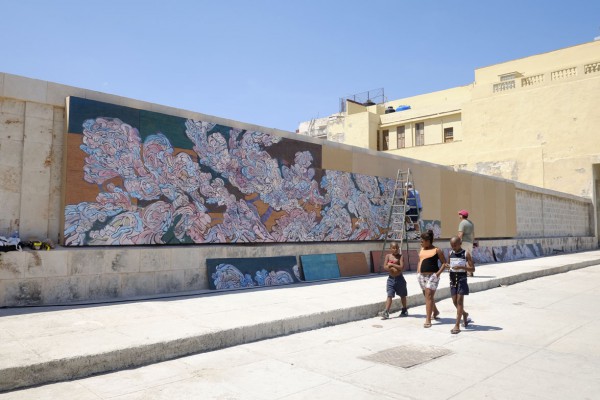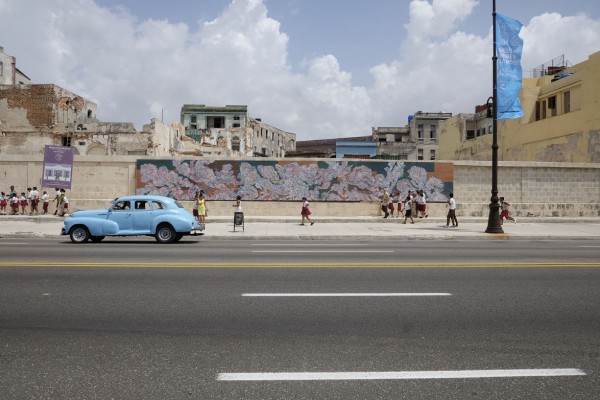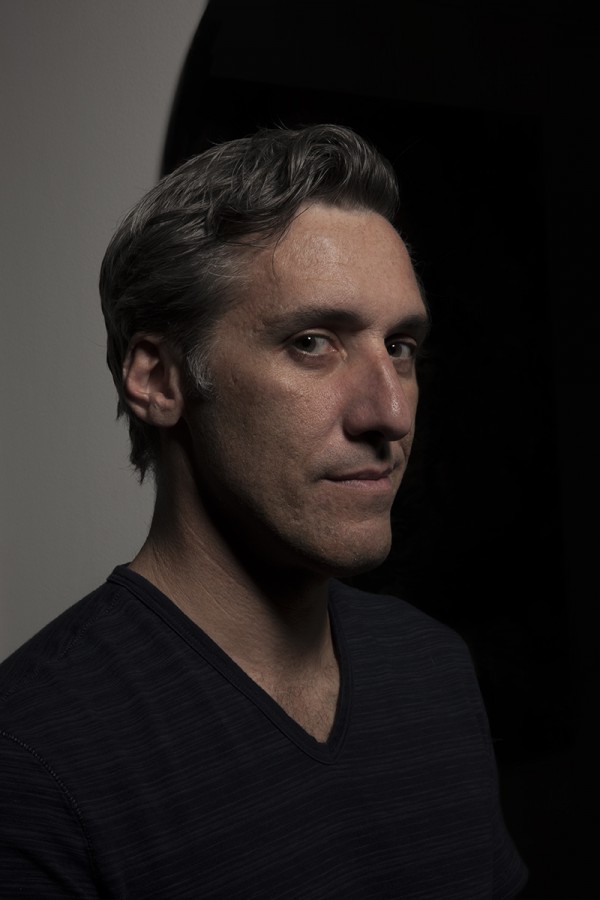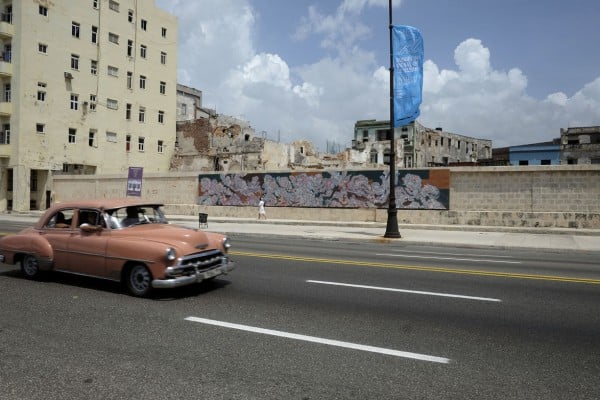Art & Exhibitions
For Havana Biennial, Emilio Perez Creates 65-Foot Mural in Homage to José Martí
They love murals down here.

They love murals down here.

Kurt McVey

Last week, Cuban-American painter Emilio Perez (b. 1972, New York, New York) returned to Cuba for the first time since 2001. The reason? To create a 65-foot site-specific installation along the Malecón—a five-mile long sea wall on the North shore of Havana. Perez’s work, Un Verso Sencillo (A Simple Verse), is part of the group exhibition Detrás Del Muro II (Behind the Wall), which will be on view during the 12th Havana Biennial (running through June 22). As per the exhibition’s curator, Juan Delgado and local art historians, the painting is the largest portable outdoor mural in the history of the city. (See Will the Havana Biennial Be a Windfall for Cuban Artists and Tania Bruguera Challenges Cuban Government with Reading On Totalitarianism During Havana Biennial.)
Un Verso Sencillo pays direct homage to José Martí, the Grandfather of Cuban independence. Martí, a poet, soldier, and philosopher, wrote the beautiful, incendiary and ultimately revolutionary 1891 work, Versos Sencillos, while exiled in New York City by the Spanish. “Martí is such an important figure in Cuban history and on both sides of the revolution,” Perez told artnet News when we visited him in the Bushwick studio he’s inhabited for 15 years. “Mostly because his work can be interpreted in so many ways.”
The New York-born Perez is by no means looking to instigate an armed revolution. The painter, much like Martí created Un Verso Sencillo in New York with the intention of it taking on new life in Cuba. The artist hopes his particular creative offering will serve as a catalyst for improved dialogue between the people of Cuba—both on the small island and abroad—as well as the larger international community. “This work is an offering to the city of Havana, its people and the sea itself. Really, it is for my family in Cuba who has somehow followed my work with what little they have,” said Perez. “I’m willing to put my heart and soul—my blood, sweat, and tears into a piece that probably won’t even survive.”

Installation view of Un Verso Sencillo (A Simple Verse) (2015).
Photo: Courtesy of the artist.
Perez’s paintings have become as well known for their stark beauty as they have for the unique process behind their creation. The artist cultivates a three-dimensional effect in his works by hand-cutting layers of acrylic paint away from a painted ground, which is often wood panel, using a transparent stencil as a guide. This technique unearths striking negative space that elevates the foreground, a maelstrom of swirls and seemingly animated gusts of floral color. “My work is about spontaneity, the subconscious, and capturing energy,” said Perez. “The process is only a vehicle to create something that looks and feels alive.”
Seemingly recognizable shapes and images tend to surface and recede in Perez’s mostly abstract works, creating a continuous and somewhat flirtatious psychedelic dialogue between the viewer and the painting itself. Though Un Verso Sencillo, in name alone, may seem fraught with over a century of political turmoil, the artist hopes it will instead be taken at face value. “I wanted this piece to function in an honest but abstract way,” the artist said. “There’s no direct visual reference to Cuba. It’s more about the feeling, the colors, the smells.”

Emilio Perez.
Photo: Ventiko
Light in tone, but ambitious in scale, Un Verso Sencillo was built using thirty-two wooden panels, tinted in faint oceanic shades of green, blue, and other tropical colors and collectively run through Perez’s aforementioned process. The work recently traveled from New York in a large shipping container procured by Delgado, who Perez calls the Winston Wolfe of the Cuban art scene.
The massive piece was assembled this past Sunday in Havana directly on a giant wall blocking off a vacant lot where two buildings previously collapsed. For the month that the work will live and breathe on the Melecón, it will be subject to the all the harsh environmental elements Cuba has to offer. “The whole city’s crumbling,” said Perez. “I didn’t want to send something flashy, overly polished, and perfect.”
This trip will mark Perez’s second pilgrimage to Cuba and comes at a time when relations between the Caribbean island and the United States are going through their most sweeping changes since the early 1960s. “I’m hoping that change happens in a responsible way,” said Perez, “but remember, the government hasn’t changed. There’s just more consensus here in the US that the embargo hasn’t done anything positive for anyone.”
Purchasing fine art from Cuban artists has been and will remain legal. However, Americans directly commissioning a Cuban artist to do work is not (see Tania Bruguera Detained During Havana Biennial). What will be interesting to see is how, moving forward, Cuban art is purchased and handled. Where it was once a trophy, a souvenir, or a symbol of acquiring slightly forbidden fruit, in the future, works will have to stand more firmly on their own artistic merit.
Perez’s first trip to Cuba coincided with Cuban Performance Art from the 1980s (Chronology), an ambitious collaboration with the Cuban artist Glexis Novoa, (whose work will also be featured in Detrás Del Muro II). Conceived in 1998, Cuban Performance Art from the 1980s (Chronology), saw the two artists traveling to Cuba in order to conduct in-person interviews with previously unrecognized performance artists who were operating on the fringes in what was and remains a challenging socio-political climate.

Installation view of Un Verso Sencillo (A Simple Verse) (2015).
Photo: Courtesy of the artist.
It was early on during that trip—at Novoa’s mother’s house in Cuba, while sifting through all the surviving posters, photographs, flyers, and physical ephemera collected from this chapter of Cuban performance art—that things came full circle for Perez. “My parents left Cuba in 1961, so all their experiences became idealized,” said Perez. “Up to that point, Cuba existed only in my imagination and from the stories told by my parents. That experience was the missing link. It bridged the gap.”
Emilio’s parents left Cuba as young adults soon after his father graduated law school. “They lost everything,” said Perez. “All they could take with them was their pride.” The family, which was part of a massive national exodus in the 60s, stopped off in Miami with Emilio’s older brother (one year old at the time) in tow, before eventually settling in Jackson Heights, New York.
Though he was born in New York in 1972, Perez’s family relocated to Rio de Janeiro, Brazil when he was 12 years old. They stayed there for several years, before returning once more to Miami, where Emilio, then in his teens, continued to struggle with his identity in high school. Emilio’s grandmothers had a big hand in raising the artist. “My parents always said that I spoke Spanish like an old Cuban woman,” Perez recalled and laughed. This fact makes it easier to forgive Emilio for neglecting his native language and Cuban roots while trying to fit in as a young American. “I didn’t want to be a Cubanaso. I can play that character but it’s not me.”
Emilio graduated from public high school in Miami and did a brief stint at Pratt Institute in 1990 during a much grittier period in New York. Falling slightly short of his expectations, and without a sufficient support system, Perez eventually returned to Miami to continue his studies at Miami Dade College. The young artist ultimately graduated in 1995 with a BFA from the University of Florida, New World School of the Arts. It was during this four-year period that Emilio re-discovered the gift of being bilingual, which served as a microcosmic launching pad for a larger bicultural identity.
After graduation, Emilio began working as a coordinator for Miami Dade College Centre Gallery, which had solid ties to New York institutions such as Exit Art and Jack Shainman Gallery. Perez was soon named Interim-Director (due to what Perez cites as bureaucratic industry laziness), launched several shows, and built up a resume and Rolodex that would carry him back to New York, a city that has served as his home base ever since.
Un Verso Sencillo is presented courtesy of Galerie Lelong, which represents Perez in New York and organized his last solo show, Footprints On the Ceiling in 2014. The work is a gift, not only to the people of Cuba, but to a younger incarnation of the artist, who, today, remembers sitting on the shores of Miami, contemplating a past and future as vivid and yet seemingly abstract as his dazzling works of pure expression. “This project should open a door and may inspire the next thing I do,” said Perez. “There’s nothing between my work and the ocean but an old sea wall. I just ask that viewers disregard their preconceived notions and take the work for what is. For me, as an artist purely, that’s always been enough.”